Pack ‘N Cool Construction Summary
N.C. State University’s Plants for Human Health Institute has developed a mobile refrigeration trailer – the “Pack ‘N Cool” – that agricultural producers can use as a model for constructing their own units. The Pack ‘N Cool combines the mobility of a cargo trailer with the refrigeration capabilities of a commercial cooler in a more cost-efficient package.
The Pack ‘N Cool model cost around $3,400 to construct, but costs will vary based on brands, quantities and parts that may already be available. Video and photo overviews of the design phases for the Pack ‘N Cool model are provided below. Customization is encouraged to meet individual needs.
Construction Manual & Budget (PDF)
Detailed Budget for Model Unit (PDF)
PACK ‘N COOL: CONSTRUCTION SUMMARY
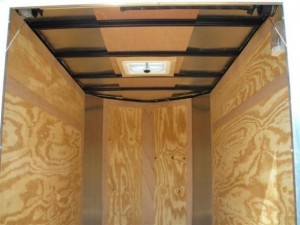 A stock 5×8 cargo trailer was purchased new for this project. Barn doors are recommended versus a ramp because they allow for more efficient control of temperatures inside the unit.
A stock 5×8 cargo trailer was purchased new for this project. Barn doors are recommended versus a ramp because they allow for more efficient control of temperatures inside the unit.
*Construction costs can be significantly reduced by purchasing a used trailer or making use of a trailer already owned.
The inside of the original stock trailer. Carefully removed all interior plywood paneling and aluminum trim. Save these materials for later reuse.
Trailer specs (may vary by model):
- 5 feet (wide) x 8 feet (long, not including 2-foot v-nose) x 5 feet (high)
- Weight (empty): 947 lbs.
- Max weight (with cargo): 2,043 lbs.
The skylight was left to help ventilate the unit, regulate temperature and reduce the moisture content.
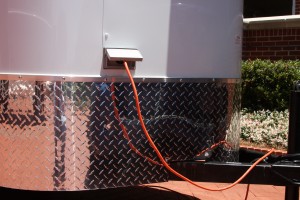
A standard RV power inlet was installed on the outside of the unit above the trailer hitch. The unit can be powered by an electrical extension cord or generator from a standard 110V power outlet.
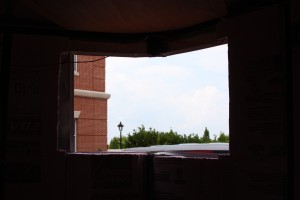 Cut hole in front of trailer just larger than the air conditioner box. Save the cutout panel for later reuse. A mounting bracket and AC unit will be installed after both layers of insulation are complete.
Cut hole in front of trailer just larger than the air conditioner box. Save the cutout panel for later reuse. A mounting bracket and AC unit will be installed after both layers of insulation are complete.
 Cut foam board insulation panels to fit between support beams in trailer (walls, floor, ceiling and doors). This is the first of two layers of insulation. About 20 panels of 2-inch foam board insulation were needed.
Cut foam board insulation panels to fit between support beams in trailer (walls, floor, ceiling and doors). This is the first of two layers of insulation. About 20 panels of 2-inch foam board insulation were needed.
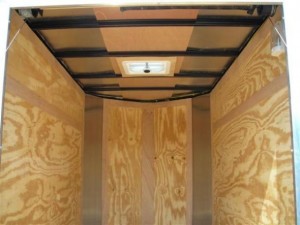 The initial layer of insulation was cut to fit snugly between all support beams and is vertically oriented. Insulation is critical to efficient temperature management, so it’s best to cover as much space as possible.
The initial layer of insulation was cut to fit snugly between all support beams and is vertically oriented. Insulation is critical to efficient temperature management, so it’s best to cover as much space as possible.
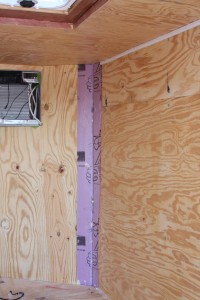 Insulation was applied to the ceiling and floor after the walls. Spray foam was used to fill in cracks around the floor boards.
Insulation was applied to the ceiling and floor after the walls. Spray foam was used to fill in cracks around the floor boards.
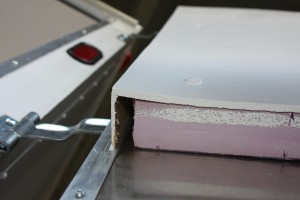 Insulation installed for a door as seen from below. The insulation was sealed in on the sides and front, but the bottom remained uncovered; feel free to seal the bottom as well.
Insulation installed for a door as seen from below. The insulation was sealed in on the sides and front, but the bottom remained uncovered; feel free to seal the bottom as well.
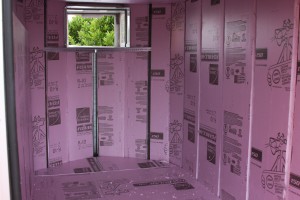 Installation of the second layer of insulation has begun on the left side of the trailer. Note that the second layer of panels has been applied horizontally (on top of the vertically-oriented first layer) to ensure optimal insulation.
Installation of the second layer of insulation has begun on the left side of the trailer. Note that the second layer of panels has been applied horizontally (on top of the vertically-oriented first layer) to ensure optimal insulation.
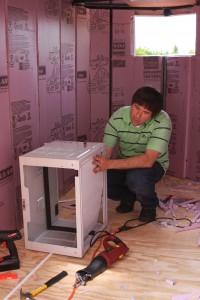 Removed air conditioner casing/frame from main unit and sealed the bottom with the panel cut from the front of the trailer for mounting the AC. Air conditioner requirements:
Removed air conditioner casing/frame from main unit and sealed the bottom with the panel cut from the front of the trailer for mounting the AC. Air conditioner requirements:
- “Window” or “Through-the-wall” unit
- 10,000 BTUs min. (12,000 BTUs preferred)
- Digital display needed for integration with CoolBot hardware
- The CoolBot website offers guidance for selecting an appropriate AC.
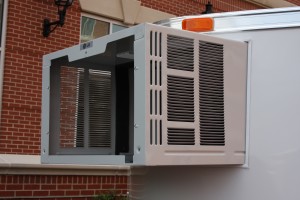 Installed a light-duty angle iron (after second layer of insulation) for mounting of AC unit.
Installed a light-duty angle iron (after second layer of insulation) for mounting of AC unit.
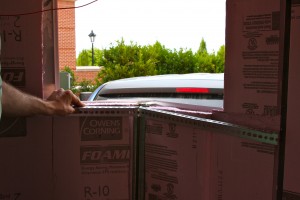 The air conditioner frame mounted and in place…
The air conditioner frame mounted and in place…
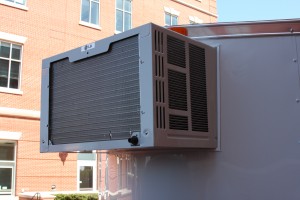 … and now with the air conditioner unit reinstalled within the frame.
… and now with the air conditioner unit reinstalled within the frame.
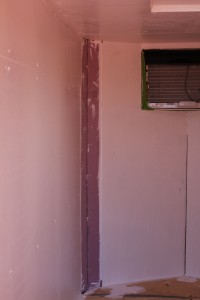 The wood siding removed at the beginning was reinstalled over the insulation and caulked to seal any gaps. For the floor, ceiling and doors, new plywood panels were cut and installed as follows:
The wood siding removed at the beginning was reinstalled over the insulation and caulked to seal any gaps. For the floor, ceiling and doors, new plywood panels were cut and installed as follows:
- Floor – 3/8-inch plywood
- Ceiling and Doors – 1/4-inch plywood
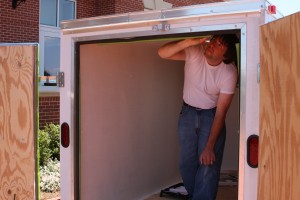 Sealed the wood paneling with two coats of polyurethane to help protect the wood from moisture or condensation damage, then sanded and applied two coats of low-VOC exterior paint.
Sealed the wood paneling with two coats of polyurethane to help protect the wood from moisture or condensation damage, then sanded and applied two coats of low-VOC exterior paint.
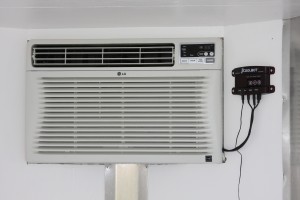 The air conditioner unit with the CoolBot equipment installed and ready to use. The CoolBot requires 110V to operate (roughly as much as a cell phone charger) and was tapped from the AC unit power cord to avoid extra wires.
The air conditioner unit with the CoolBot equipment installed and ready to use. The CoolBot requires 110V to operate (roughly as much as a cell phone charger) and was tapped from the AC unit power cord to avoid extra wires.
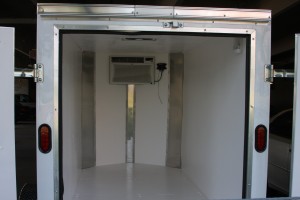 The finished interior of the Pack ‘N Cool model unit is roughly 50 square feet and can reach temperatures in the 30s.
The finished interior of the Pack ‘N Cool model unit is roughly 50 square feet and can reach temperatures in the 30s.
The completed Pack ‘N Cool unit ready for use at the farmers market, in the field and other locations.
Disclaimer
Recommendations for the use of any construction materials are included on this website as a convenience to the reader. The use of brand names and any mention or listing of commercial products or services in this publication does not imply endorsement by N.C. State University nor discrimination against similar products or services not mentioned. Individuals who use construction materials are responsible for ensuring that the intended use complies with current regulations and conforms to the product’s intended purpose. Be sure to obtain current information about structural integrity and consult the retailer with questions about the strength of the equipment or compatible hardware.
- Categories: